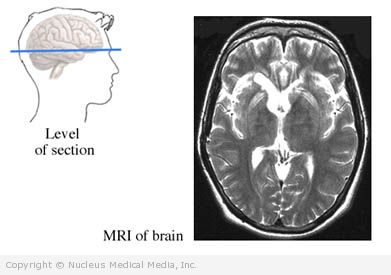Creutzfeldt-Jakob Disease
(Subacute Spongiform Encephalopathy; CJD)
Creutzfeldt-Jakob Disease – Definition
Creutzfeldt-Jakob disease (CJD) is a rare, fatal, degenerative brain disorder characterized by rapidly progressive dementia.
CJD can be categorized into different subtypes:
- Sporadic (classical) CJD — most common type; usually affects people aged 50 years and older
- Familial CJD — an inherited form of the disease
- Iatrogenic CJD — contracted through medical procedures, such as injections of growth hormone or receipt of corneal transplants or dura mater implants from affected donors
- New variant CJD (vCJD) — caused by eating contaminated beef products, which may cause bovine spongiform encephalopathy (BSE)
- BSE is commonly known as mad cow disease. vCJD differs from other forms of CJD because it affects younger people and has a longer average time course.
Creutzfeldt-Jakob Disease – Causes
There has been a great deal of scientific research about the cause of CJD. Today, it is generally believed that most noninherited cases are caused by infectious proteins called prions. Prions can transform normal protein molecules into abnormal, disease-causing molecules.
Creutzfeldt-Jakob Disease – Risk Factors
These factors increase your chance of developing CJD. Tell your doctor if you have any of these risk factors:
- Age: CJD most commonly occurs in people aged 50-75 years
- Use of cadaveric growth hormone
- Cornea transplants
- Dura mater grafts
- Family members with CJD (Approximately 10%-15% of cases are inherited.)
- Eating beef products produced by countries with an epidemic of BSE (mad cow disease)
- Healthcare workers who work with brain tissues
- Blood transfusion from someone with CJD
Creutzfeldt-Jakob Disease – Symptoms
Initially, there are no symptoms. As CJD progresses, symptoms that may occur include:
- Memory lapses
- Difficulty concentrating
- Impaired judgment
- Difficulty with speech
- Loss of coordination
- Blurred vision
- Behavior and mood changes
- Muscle spasms
- Seizures
- Loss of mental and physical function
Depending on the type of CJD, the disease may last from 3-36 months, or occasionally longer, and is almost always fatal.
Creutzfeldt-Jakob Disease – Diagnosis
Your doctor will ask about your symptoms and medical history, and perform a physical exam.
CJD is a difficult disease to diagnose. There is no single test for detection. The following tests may be used to help make a diagnosis:
- Electroencephalogram (EEG) — a test that records the brain’s activity by measuring electrical currents made by the brain
- Computed tomography (CT) scan — a type of x-ray that uses a computer to make pictures of the inside of the body, in this case the brain
- Magnetic resonance imaging (MRI) scan — a test that uses magnetic waves to make pictures of the inside of the body, in this case the brain
- Brain Positron emission tomography (PET) scan — a scan evaluating the use of glucose by different parts of the brain
- Brain biopsy — removal of a sample of brain tissue for testing
- Blood tests and lumbar puncture — to obtain cerebrospinal fluid; this may be helpful in distinguishing CJD from other diseases with similar symptoms, such as Alzheimer’s disease.
Creutzfeldt-Jakob Disease – Treatment
There is no cure for CJD. The aim of treatment is to relieve pain and alleviate symptoms.
Drug therapy may include:
- Opiates to treat pain
- Anticonvulsive drugs to help decrease neuromuscular problems
Creutzfeldt-Jakob Disease – Prevention
To avoid the new variant form of this condition, it is recommended that you avoid eating beef produced in areas that may have BSE (mad cow disease). There are no known ways to prevent other forms of CJD.

